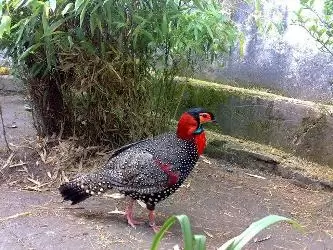Population of endangered western tragopan goes up in Himalayan Park

08-May-2012
Vol 3 | Issue 18
The presence of the highly endangered, elusive western tragopan can now be felt more clearly in the Great Himalayan National Park in Himachal Pradesh, with its numbers multiplying.
Park authorities say the population of this brilliantly coloured pheasant species in the park has gone up and so has its sighting.
 |
|
The western tragopan's numbers in Himachal's Great Himalayan National Park have increased as per latest surveys (Photo: IANS)
|
"The density of the western tragopan in the park was 6.5 birds per sq km (in this year's census). Last year, it was six birds per sq km, while it was just five birds in 2010," said Park Director Ajay Srivastav.
For population estimation, the western tragopan, like other pheasant species, needs specialised techniques.
One of the standard census techniques is recording their call counts at a specified time and location.
Srivastav said that estimation was done at 18 locations. "This exercise is now part of regular monitoring protocol being followed in the park to ascertain the status of population dynamics of the western tragopan."
As per the estimation figures of the last two-three years, it is clear that the population of the western tragopan is on the rise.
Srivastav attributed the increase to management strategies in terms of protection through regular patrolling of the area.
From March-end till mid-June, all pheasant species breed. "The male tragopan gives a loud chorus before dawn during the breeding season. In the estimation, every male call is counted, which gives an index of the population in a specified area," Srivastav said, adding, "The mating call is different from the distress call."
During the estimation, all teams were given Global Positioning Systems (GPS) and data sheets to record the altitude and the calls of the tragopan.
In this method, it is assumed that each call can be equated to a breeding pair, Srivastav said.
The western tragopan belongs to the family Phasianidae, which also includes peafowl and red jungle fowl. It's the least studied bird in the world.
Being a shy bird, it is rarely sighted and is found at an altitude of 2,000 to 3,600 metres in the temperate forests of Jammu and Kashmir, Himachal Pradesh and Uttarakhand.
Jennifer R.B. Miller, who studied the park in April-May 2008 during the US Fulbright Student Research Scholarship, says the populations of three pheasant species - western tragopan, koklas and Himalayan monal - in the Great Himalayan National Park have grown since surveyed in the late 1990s.
"Surveys conducted in the late 1990s indicated that pheasant populations in the park were declining. In 1999, the government legally notified the park and the authorities began enforcing the Indian Wildlife (Protection) Act.
Relative abundances of all three pheasant species were significantly higher (in 2008) than in previous surveys," says Miller in her paper titled "Himalayan pheasants in the Great Himalayan National Park" published in the Indian Birds journal in 2010.
With magnificent glaciers, lofty mountains and gurgling streams, the Great Himalayan National Park, spread over 754 sq km in Kullu district, is one of the richest biodiversity sites in the western Himalayas.
The park is home to 203 bird species and 31 mammal species, three reptiles, nine amphibians and 127 insect species, besides 425 species of plants.
The famous mammals in the park are the leopard, the Himalayan black bear, the brown bear, the rhesus macaque and various herbivores like the goral, a small antelope, and the Himalayan tahr, a wild goat that lives on the steepest cliffs.
One of the most elusive species in the park is the snow leopard. It can be spotted in the highest portions, adjoining the Pin Valley National Park.
The best time to visit the park is April-May and September-November. - IANS















